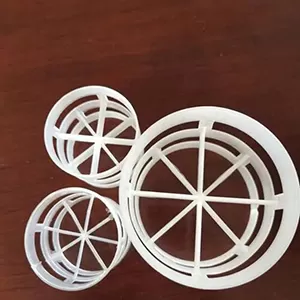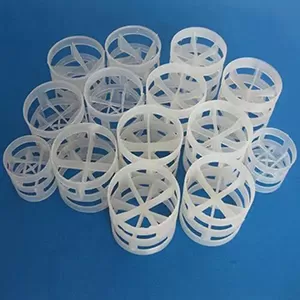Surface treatment of plastic packing is crucial to enhance its performance, such as improving wettability and corrosion resistance. This article will discuss the main surface treatment methods for plastic packing.

Chemical etching is a commonly used surface treatment method. It involves exposing the plastic packing to chemical solutions, such as acids or alkalis, to etch the surface. This process creates micro - pores and irregularities on the surface, increasing the specific surface area. For example, polypropylene (PP) packing can be treated with chromic acid solution, which reacts with the surface molecules to form a rougher texture. The increased surface roughness improves the wettability of the packing, allowing liquids to spread more evenly across the surface instead of beading up. This is particularly beneficial in absorption and distillation processes, where efficient gas - liquid contact is essential. However, careful control of the etching time and solution concentration is necessary to avoid over - etching, which could weaken the structural integrity of the packing.
Plasma treatment is another effective method, especially for improving surface energy and adhesion. In this process, the plastic packing is exposed to a low - temperature plasma, which consists of highly reactive ions, electrons, and free radicals. The plasma particles bombard the surface of the plastic, breaking chemical bonds and introducing polar functional groups (such as hydroxyl or carboxyl groups). This modification enhances the surface energy, making the packing more receptive to liquids and coatings. Plasma treatment is versatile and can be applied to various plastic materials, including PP, polyethylene (PE), and polyvinyl chloride (PVC). It is a dry process that does not require harmful chemicals, making it environmentally friendly. Additionally, it can be used to treat complex shapes of packing, ensuring uniform surface modification across all areas.
Coating is a widely adopted method to impart specific properties to plastic packing. A variety of coatings can be applied, depending on the desired performance. For instance, anti - corrosion coatings, such as polytetrafluoroethylene (PTFE) coatings, can be applied to plastic packing used in highly corrosive environments. These coatings form a protective barrier, preventing the underlying plastic from coming into direct contact with corrosive media. Hydrophilic coatings are used to improve wettability, which is useful in processes where liquids need to spread quickly over the packing surface. Alternatively, hydrophobic coatings can be applied to reduce liquid adhesion, preventing fouling in applications involving viscous or sticky fluids. The coating can be applied using methods like spraying, dipping, or electrostatic deposition, ensuring even coverage.
Flame treatment is a simple and cost - effective surface treatment method. It involves briefly exposing the plastic packing to a controlled flame, which oxidizes the surface. The oxidation introduces polar groups on the surface, increasing surface energy and improving wettability and adhesion. Flame treatment is particularly suitable for large - scale production due to its high processing speed. However, it requires precise control of the flame intensity and exposure time to avoid damaging the plastic. Over - exposure can cause melting or discoloration of the packing, affecting its performance and appearance.

UV irradiation is a surface treatment method that uses ultraviolet light to modify the surface of plastic packing. The high - energy UV photons break chemical bonds on the surface, leading to cross - linking or chain scission of the polymer molecules. This results in changes in surface roughness and the introduction of polar groups, enhancing wettability and adhesion. UV irradiation is a clean and energy - efficient process, and it can be easily integrated into continuous production lines. It is especially effective for treating thin - walled or delicate plastic packing where other methods might cause damage.
In summary, surface treatment methods for plastic packing include chemical etching, plasma treatment, coating, flame treatment, and UV irradiation. Each method has its own advantages and applications, and the choice depends on the type of plastic, the desired performance improvements, and the production scale. Proper surface treatment can significantly enhance the functionality and durability of plastic packing in various industrial processes.



